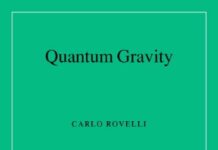
Ebook Info
- Published: 2014
- Number of pages: 266 pages
- Format: PDF
- File Size: 8.93 MB
- Authors: Carlo Rovelli
Description
Quantum gravity is among the most fascinating problems in physics. It modifies our understanding of time, space and matter. The recent development of the loop approach has allowed us to explore domains ranging from black hole thermodynamics to the early Universe. This book provides readers with a simple introduction to loop quantum gravity, centred on its covariant approach. It focuses on the physical and conceptual aspects of the problem and includes the background material needed to enter this lively domain of research, making it ideal for researchers and graduate students. Topics covered include quanta of space; classical and quantum physics without time; tetrad formalism; Holst action; lattice QCD; Regge calculus; ADM and Ashtekar variables; Ponzano-Regge and Turaev-Viro amplitudes; kinematics and dynamics of 4D Lorentzian quantum gravity; spectrum of area and volume; coherent states; classical limit; matter couplings; graviton propagator; spinfoam cosmology and black hole thermodynamics.
User’s Reviews
Editorial Reviews: Book Description A comprehensible introduction to the most fascinating research in theoretical physics: advanced quantum gravity. Ideal for researchers and graduate students. About the Author Carlo Rovelli is Professor of Physics at Université d’Aix-Marseille, where he directs the gravity research group. He is one of the founders of loop quantum gravity theory.Francesca Vidotto works at Radboud Universiteit Nijmegen and initiated the spinfoam approach to cosmology.
Reviews from Amazon users which were colected at the time this book was published on the website:
⭐This is an exciting subject to read about. The opening pages discuss how at the scale of ten to the power of minus thirty three centimeters , the Planck scale , strange things happen. General relativity predicts that a particle confined to a very small space should form a black hole. The Schwarzschild radius is proportional to the mass of the particle assuming the particle is sufficiently concentrated to form a black hole. General relativity allows the Schwarzschild radius to be arbitrarily small. Giving correct numerical factors and combining the argument with Quantum Mechanics in terms of the Heisenberg uncertainty principal predicts a minimum size for the localization and this turns out to be Plank scale. This argument is detailed in the book by the authors with correct numerical factors given. The argument is in some ways academic because micro-black holes probably do not exist but it does show an inherit contradiction between General Relativity and Quantum Mechanics. The argument also shows the scale at which we expect quantum gravity to be important. The argument outlined was given by Bronstein an early pioneer of Quantum Gravity. Quantum Gravity is important for example to understand early cosmology of the universe but mostly it is to try to resolve the inherit contradictions between Quantum Theory and General Relativity. These contradictions can be seen in other ways.The book requires understanding of SU(2), SO(1,3), and their irreducible representations in spinor space. Very early on by looking at a tetrahedron and postulating a quantum relation similar to that of angular momentum in elementary quantum mechanics we deduce that area is quantized for the tetrahedron (just as the total angular momentum is quantized in quantum mechanics). We also deduce that distance itself has a fuzziness at this scale! The book proceeds from there.The book is not “elementary” since there is much impressive math and physics but this should not put one off reading this book but instead be motivation for reading from external sources to fill in the gaps and gain a better understanding of this exciting subject. To me it does seem like this theory is the correct theory for uniting General Relativity and Quantum Theory rather than thinking about higher dimensional spaces and as further evidence of this there is a chapter (Chapter 8, Continuum limit) showing how in outline Einstein’s equations can be deduced from these spinor equations. A complete understanding would only be achieved by a specialist in the field but this should not put one off reading about what has been achieved. The ideas here will definitely expand your horizons and this is a must to read for anyone interested in Physics. However to gain the most from this book supplementary reading will definitely be necessary.
⭐As the title of thsThis evaluation (3 stars) is not to degrade the context of this excellent book. But if you are to order this book, you better go with the printed version and not the Kindle one, as will you really find it difficult and bothering reading the mathematical equations, terms, and symbols in their scanned form that appear quite small and faded if not illegible.There is no way you can enlarge such scanned “images”. It is really frustrating that e-books cannot follow (or imitate) the advanced standard or the format of PDF texts in which there is no difference between ordinary texts and specialized symbols or formulas either in their sharpness or size.I hope sometimes Kindle takes care of this problem. Mind, it is not a wishful thinking since it is surely doable, provided that a plethora of serious consumers (readers) demand it from Amazon or Kindle. Recall that in early versions of Kindle book it was impossible to refer to the page number of a scholarly book or any book you were reading (only the digital “locaton” was given), but this flaw does is already dealt with (the page number is now given in the Kindle edition as you click on a line).
⭐Compared to other textbooks of quantum gravity the approach is rigorous as well, but the description is extensive and in some way self contained. A lot of effort and attention is devoted to make the extremely sophisticated physical concepts and mathematical formalism understandable. Effective in explaining the inner features of reality.
⭐Not really an introduction. Doesn’t define many terms and operations. Not recommend for graduate students. May be useful to researchers.
⭐Misses it’s goal a bit, it wasn’t quite as low level as the authors anticipated. The preface states “assumes only some basic knowledge of general relativity, quantum mechanics and quantum field theory.” This is very untrue, you must know considerably more than this. The middle chapters require you to be quite comfortable with differential forms and alternative formulations of the Einstein-Hilbert action.That being said, if you rewrite that sentence to assume comfort with GR, QFT and differential geometry, this book is the best book hands down for learning covariant LQG.
⭐The problem with readability of the equations has been fixed in the version I downloaded. This introduction is very readable, but as others have stated it does require considerable prior knowledge and facility with QM and GR.
⭐The book is well written and covers the topic very well. Equations and mathematical concepts are liberally used, but anyone with some higher math can follow the book and gain insight into this fascinating subject.
⭐excellent
⭐Beware! – the Kindle version of the book is unreadable both on Android and iOS because any free-standing equations are rendered in a microscopic font. The equations are rendered as image snippets in the Kindle Cloud Reader in a browser, so they are legible in that case.I found the content of the book itself to be excellent. It was pitched at just the level I needed to get a broad understanding of the area.
⭐Very clear explanation of what to me is a new subject. The included maths is very clear.
⭐Clear, concise friendly
⭐Very interesting description of the concepts and math behind the loop quantum gravityOnly 4 stars because the variables are not described anywhere. For instance everybody knows that G is the Gravitational constant but it should be mentionned at least once the first time G appears in the text!
⭐Il s’agit ici d’un livre d’introduction à la gravité quantique à boucles sous sa version covariante. La présentation est très pédagogique, avec une motivation détaillée de cette approche de la gravitation quantique et qui est en pleine expansion ces dernières années. L’approche est à mon avis plus prometteuse et cohérente que celle de la théorie des supercordes. L’espace-temps est ici directement quantifié, ce qui a longtemps posé des difficultés mathématiques mais qui sont en voie d’être résolues. Ainsi le volume et l’aire prennent des valeurs discrètes et non plus continues.Cette théorie contient la relativité générale et la théorie quantique des champs comme approximations à basse énergie.Des applications sont données à la cosmologie primordiale et à la théorie des trous noirs (en particulier le rayonnement de Hawking, retrouvé ici directement). La cohérence de la gravitation quantique à boucles me semble très prometteuse.Toutefois les calculs sont pour la plupart laissés aux bons soins du lecteur, je n’ai pas pris, en ce qui me concerne, la peine de les faire faute de temps.Quant au niveau de cet ouvrage, il me semble de fin de master ou doctorat de physique. Il faut avoir des connaissances sur les bases de la relativité générale et de la théorie quantique des champs.
⭐
Keywords
Free Download Covariant Loop Quantum Gravity: An Elementary Introduction to Quantum Gravity and Spinfoam Theory (Cambridge Monographs on Mathematical Physics) 1st Edition in PDF format
Covariant Loop Quantum Gravity: An Elementary Introduction to Quantum Gravity and Spinfoam Theory (Cambridge Monographs on Mathematical Physics) 1st Edition PDF Free Download
Download Covariant Loop Quantum Gravity: An Elementary Introduction to Quantum Gravity and Spinfoam Theory (Cambridge Monographs on Mathematical Physics) 1st Edition 2014 PDF Free
Covariant Loop Quantum Gravity: An Elementary Introduction to Quantum Gravity and Spinfoam Theory (Cambridge Monographs on Mathematical Physics) 1st Edition 2014 PDF Free Download
Download Covariant Loop Quantum Gravity: An Elementary Introduction to Quantum Gravity and Spinfoam Theory (Cambridge Monographs on Mathematical Physics) 1st Edition PDF
Free Download Ebook Covariant Loop Quantum Gravity: An Elementary Introduction to Quantum Gravity and Spinfoam Theory (Cambridge Monographs on Mathematical Physics) 1st Edition



